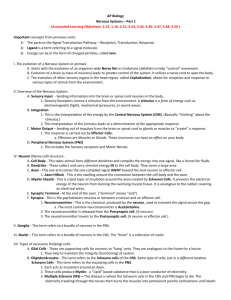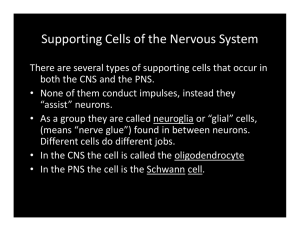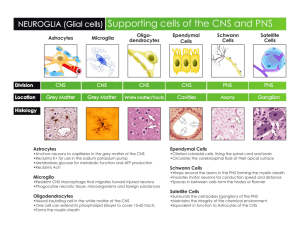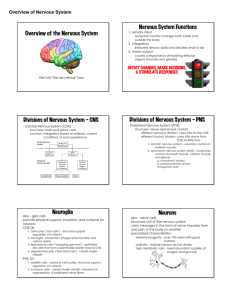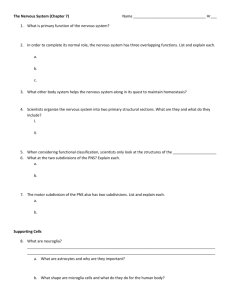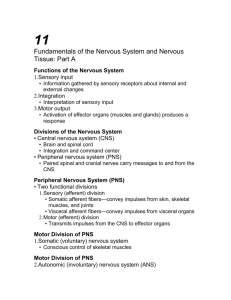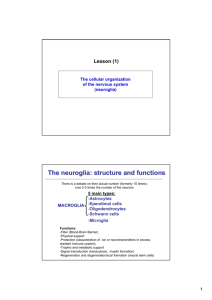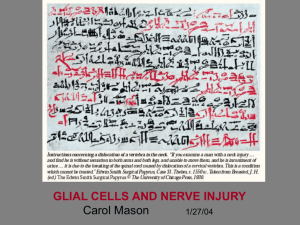Chapter 12 - Neural Tissue
advertisement
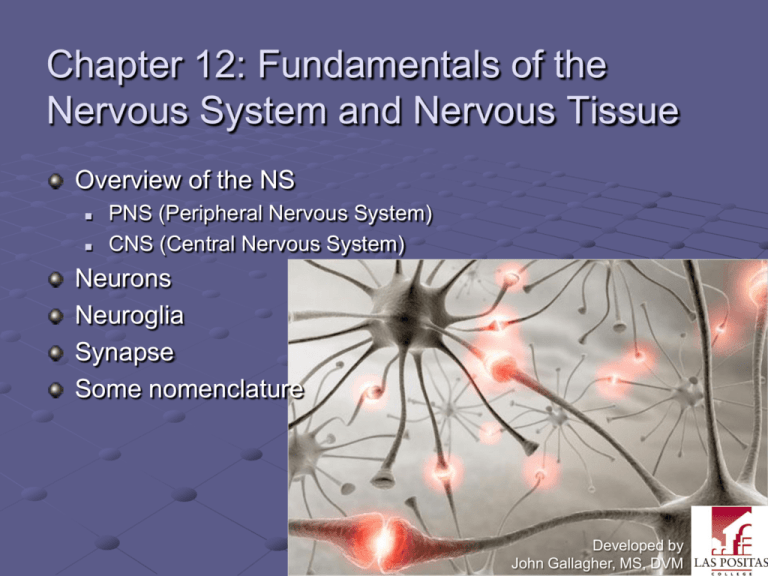
Chapter 12: Fundamentals of the Nervous System and Nervous Tissue Overview of the NS PNS (Peripheral Nervous System) CNS (Central Nervous System) Neurons Neuroglia Synapse Some nomenclature Developed by John Gallagher, MS, DVM Functional Overview of NS CNS = Brain and Spinal Cord Integration, processing and coordination of sensory data and motor commands Higher functions PNS 1. Sensory or afferent division with sensory neurons. Brings sensory info from PNS to CNS. Begins at receptors 2. Motor or efferent division with motor neurons. Brings motor commands to peripheral tissue. Ends at effector cells. Functional Overview of NS Made up of neurons and neuroglia Similar to fig 12.3 Cellular Organization of Neural Tissue Two cell types: 1. Neurons 1. “Excitable” cells 2. Neuroglia (mostly not excitable) Schwann cells Satellite cells Astrocytes Oligodendrocytes Microglial cells Ependymal cells 1. Neurons Cell body or Soma with Perikaryon Dendrites Axon with axon hillock Synaptic terminals Typical structure: Fig 12.4 Cell body = Soma = RER The “signal,” or Action Potential is carried along the neurilemma Faster if axon is myelinated Nerve structure •A nerve is USUALLY both sensory and motor (axons transmit only in one direction). •Some significant exceptions in cranial nerves •Similar to muscle terminology •Epineurium •Covers the nerve •Perineurium •Covers a fascicle •Endoneurium •Covers an axon Fig 12.16, p 333 Synapse Site of communication between two nerve cells or nerve cell and effector cell Presynaptic and postsynaptic neurons Neuro-effector junctions, e.g., Motor End Plate Electrical vs. chemical synapses Chemical Synapse vs. Electrical Synapse Space between two cells Signal transduction via a neurotransmitter, usually ACh Most common Direct physical contact between cells = gap junctions Direct signal transduction Rare, but occurs in CNS and HEART Chem. Synapse Structure 1. 2. 3. 4. Axon terminal of presynaptic cell, with vesicles of neurotransmitter(NT) Synaptic cleft Dendrite or cell body of postsynaptic cell Unidirectional Color enhanced TEM x 186,480 Structural Neuron Classification Anaxonic In CNS and Sense Organs Unipolar Also called pseudounipolar Sensory neurons See fig. 12.2 Structural Neuron Classification cont. . . Bipolar Unmyelinated Rare, but important in special senses Multipolar Most common All motor neurons Functional Neuron Classification 1) Sensory (Afferent) 1) Somatic 2) Visceral 2) Motor (Efferent) 1) Somatic 2) Visceral 3) Interneurons Neuron Organization Divergence - One neuron synapses with several, effectively "spreading the word". Convergence - Several neurons synapse with a single neuron, concentrating the input. Serial processing - step-wise, sequential Parallel processing - simultaneous processing of different information 2. Neuroglia (glue) AKA Glial Cells 10-50 X more glial cells than neurons Supporting Cells Structural and nutritional Enhance conduction Schwann cells (neurolemmocytes) Ability to divide Think about tumors (malignant glioma) New Information: Some glial cells are excitable 2. Neuroglia (glue), cont’d In the CNS: Astrocytes Microglia Ependymal Cells Oligodendrocytes In the PNS: Schwann Cells Satellite cells Astrocytes: largest & most numerous BBB, control of environment structural framework & repairs regulation of ions, nutrients, gases Microglial cells Smallest Phagocytosis # during infection or injury Derived from white blood cells Ependymal cells Lining of ventricles & central canal Some regions ciliated Some specialized to produce and monitor CSF Oligodendrocytes Smaller than astrocyte Cover neurons with myelin in CNS (white matter vs. gray matter!) Myelin improves the rate of impulse conduction Schwann Cells (in the PNS) Myelinated Nonmyelinated “Satellite cells surround neuron cell bodies within ganglia.” Refer to Fig 12.7 The Myelin Sheath p 357 The lipoprotein myelin is wrapped around and around the axon in myelinated nerves. Node of Ranvier = gap between neurolemmocytes In CNS: Called oligodendrocytes In PNS: Called neurolemmocytes or Schwann Cells Demyelination Multiple sclerosis (p 365) Autoimmune destruction of myelin sheath in the CNS Young adult women Usually idiopathic Genetic? Guillain-Barré Syndrome Autoimmune destruction of myelin sheath in the PNS Usually a consequence of an infectious disease Leg weakness Some Terminology Collections of cell bodies – ganglion in PNS nucleus in CNS Bundles of axons (or fibers) – tracts in CNS nerves in PNS “White matter” = myelinated axons, both nerves and tracts “Gray matter” = nonmyelinated material, dendrites, synapses and cell bodies as well as nonmyelinated axons. In CNS – nucleus; in PNS ganglia The circuit fig 12.9 Schwann Cells: AKA neurolemmocytes Surround all peripheral axons! Responsible for myelination of PNS Involved in repair mechanism after injury Wallerian Degeneration myelinated
